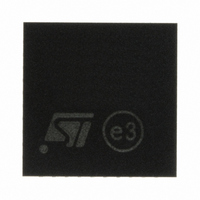SN260Q STMicroelectronics, SN260Q Datasheet - Page 24

SN260Q
Manufacturer Part Number
SN260Q
Description
IC ZIGBEE/802.15.4 PROC 40-QFN
Manufacturer
STMicroelectronics
Datasheet
1.SN260Q.pdf
(47 pages)
Specifications of SN260Q
Frequency
2.4GHz
Modulation Or Protocol
802.15.4
Applications
ZigBee™
Power - Output
-32dBm ~ 5dBm
Sensitivity
-97.5dBm
Voltage - Supply
2.1 V ~ 3.6 V
Current - Receiving
35.5mA
Current - Transmitting
35.5mA
Data Interface
PCB, Surface Mount
Antenna Connector
PCB, Surface Mount
Operating Temperature
-40°C ~ 85°C
Package / Case
40-QFN
For Use With
497-6404 - BOARD EVAL SPZB260 MOD FOR STR9497-5990 - KIT EVAL REVA FOR ZIGBEE497-5879 - NETWORK DEVELOPMENT FOR SN260497-5877 - KIT RADIO CARRIER FOR SN260
Lead Free Status / RoHS Status
Lead free / RoHS Compliant
Memory Size
-
Data Rate - Maximum
-
SPI protocol
7.2.5
7.2.6
Note:
24/47
backup of data in the SN260. The SN260 will de-assert the nHOST_INT signal after
receiving a byte on the SPI. Due to inherent latency in the SN260, the timing of when the
nHOST_INT signal returns to idle can vary between transactions. nHOST_INT will always
return to idle for a minimum of 10µs before asserting again. If the SN260 has more output
available after the transaction has completed, the nHOST_INT signal will assert again after
Slave Select is de-asserted and the Host must make another request.
Spacing
To ensure that the SN260 is always able to deal with incoming commands, a minimum inter-
command spacing is defined at 1ms. After every transaction, the Host must hold the Slave
Select high for a minimum of 1ms. The Host must respect the inter-command spacing
requirement, or the SN260 will not have time to operate on the command; additional
commands could result in error conditions or undesired behavior. If the nHOST_INT signal
is not already asserted, the Host is allowed to use the Wake handshake instead of the inter-
command spacing to determine if the SN260 is ready to accept a command.
Waking the SN260 from sleep
Waking up the SN260 involves a simple handshaking routine as illustrated in
handshaking ensures that the Host will wait until the SN260 is fully awake and ready to
accept commands from the Host. If the SN260 is already awake when the handshake is
performed (such as when the Host resets and the SN260 is already operating), the
handshake will proceed as described below with no ill effects.
A wake handshake cannot be performed if nHOST_INT is already asserted.
Figure 6.
Waking the SN260 involves the following steps:
1.
2.
3.
4.
5.
6.
7.
8.
Host asserts nWAKE.
SN260 interrupts on nWAKE and exits sleep.
SN260 performs all operations it needs to and will not respond until it is ready to accept
commands.
SN260 asserts nHOST_INT within 10ms of nWAKE asserting. If the SN260 does not
assert nHOST_INT within 10ms of nWAKE, it is valid for the Host to consider the
SN260 unresponsive and to reset the SN260.
Host detects nHOST_INT assertion. Since the assertion of nHOST_INT indicates the
SN260 can accept SPI transactions, the Host does not need to hold Slave Select high
for the normally required minimum 1ms of inter-command spacing.
Host de-asserts nWAKE after detecting nHOST_INT assertion.
SN260 will de-assert nHOST_INT within 25 µs of nWAKE de-asserting.
After 25µs, any change on nHOST_INT will be an indication of a normal asynchronous
(callback) event.
SN260 wake sequence
Figure
6. This
SN260












